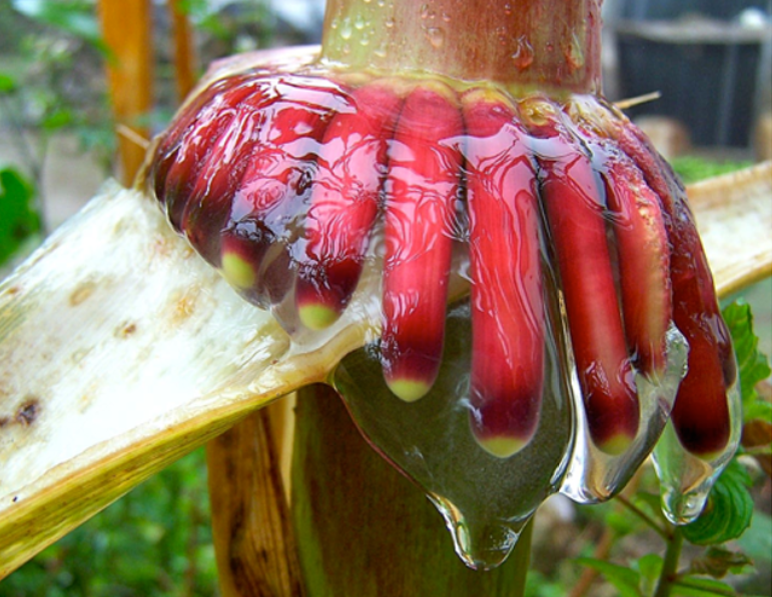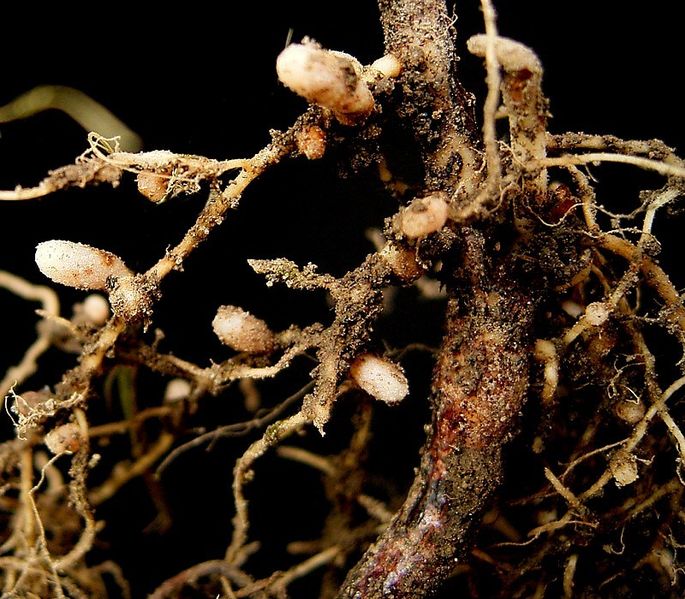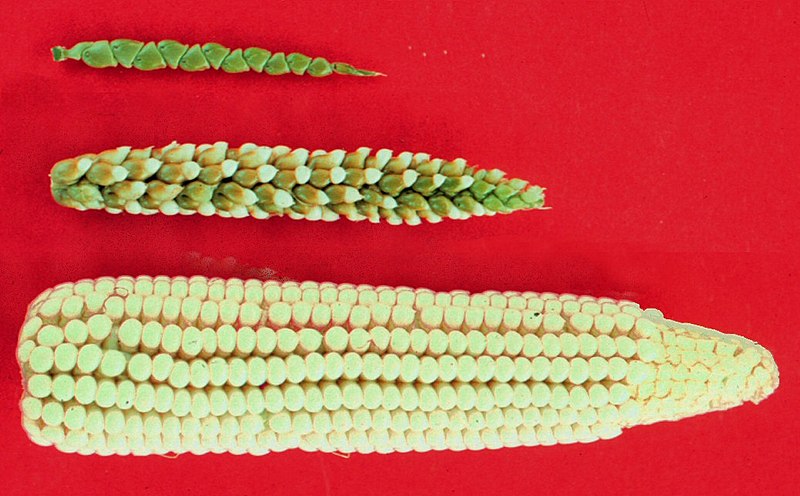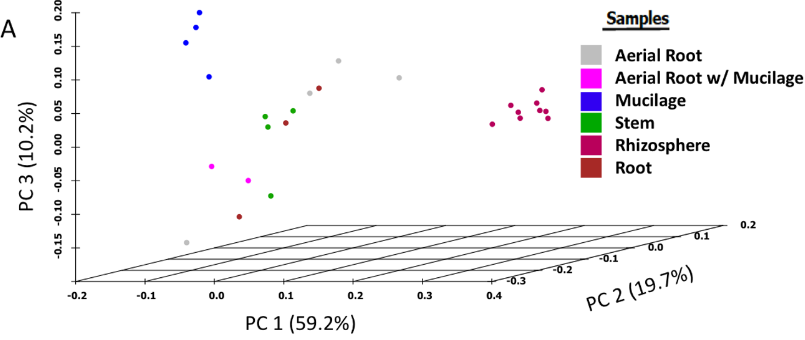Bugs in the news: Corn snot helping end hunger and pollution
steemstem·@effofex·
0.000 HBDBugs in the news: Corn snot helping end hunger and pollution
Believe it or not, there's no need for a nsfw tag. What you're looking at is a very special corn root. In fact, it's so special, it took researchers over 8 years to be sure about what they were looking at. These roots aren't in soil, are covered with a hefty helping of slime, and host a thriving community of very special microbes.<sup>[ref](http://journals.plos.org/plosbiology/article?id=10.1371/journal.pbio.2006352)</sup> <center>  </center><center> <sup>Behold the beauty of nature. Image from Fig. 2 of the [research article](http://journals.plos.org/plosbiology/article?id=10.1371/journal.pbio.2006352) released by Deynze et al. as [open access](https://www.plos.org/open-access)</sup></center> Nitrogen is the **N** in [CHONPS](https://en.wikipedia.org/wiki/CHON), the big elements of life. Despite its importance, nitrogen can be rather hard to come by in a *[usable form](https://www.sciencelearn.org.nz/resources/960-the-nitrogen-cycle)*. Even though something like 78% of our atmosphere is nitrogen, the form it takes (N<sub>2</sub> or dinitrogen) has an incredibly stable and hard to break triple bond<sup>1</sup>, making it difficult for life to use (*bioavailability*). Because of this, there's no apparent end to the [wacky hijinks](https://steemit.com/steemstem/@effofex/fungal-worm-hunters) organisms [will go through](https://steemit.com/steemstem/@effofex/a-pitcher-plant-ecosystem-or-i-eat-flies-with-a-little-help-from-my-friends) to [get](https://steemit.com/ecology/@mountainwashere/ecology-writ-small-in-the-stomach-of-a-carnivorous-plant) their [necessary nitrogen](https://steemit.com/nature/@valth/the-pineapple-plant-is-able-to-eat-and-digest-animal-meat?sort=author_reputation). We humans are not excluded. Our wacky hijinks boil down to [careful stewardship of the land and coplanting](https://steemit.com/steemstem/@effofex/trifolium-and-its-billions-of-helpers-a-holiday-themed-nitrogen-festival), which are excellent but may not be scalable, or by [using copious amounts of (often polluting, non-renewable) energy](https://steemit.com/steemstem/@justtryme90/the-history-of-chemistry-the-haber-process-a-reaction-few-know-about-but-all-are-dependent-on) to [zap dinitrogen into a more useful form](https://steemit.com/steemstem/@lesshorrible/the-nitrogen-debacle-the-force-of-industry-imitating-nature-and-a-decentralized-solution). Fortunately for us, the wacky hijinks used by the snotty corn (officially a [landrace](https://en.wikipedia.org/wiki/Landrace) of corn from Oaxaca, Mexico) may eventually give us another option. # Of crops and cooperation Here's what you need to know. *All* plants need nitrogen to grow, yet none of them<sup>2</sup> can convert (*fix*) dinitrogen into useful form. Luckily, there are special bacteria which excel at doing just that. An even luckier for *some* plants is that they've formed a very close relationship with those bugs - [in return for providing a comfy home full of carbon in their root nodes, these plants get nitrogen from symbiotic nitrogen fixing bacteria (*rhizobia*)](https://steemit.com/steemstem/@effofex/trifolium-and-its-billions-of-helpers-a-holiday-themed-nitrogen-festival). <center>  </center><center> <sup>Lotus root with rhizobial nodules, [source](https://commons.wikimedia.org/wiki/File:Lotus_pedunculatus11_ies.jpg) by Frank Vincentz under [CC3](https://creativecommons.org/licenses/by-sa/3.0/deed.en)</sup></center> Unfortunately for many plants, and for us, this association doesn't happen in every plant. Rhizobial symbiosis is largerly limited to legumes, and while beans and such *are* staple foods, we [produce far, far more cereals](https://www.researchgate.net/figure/World-production-of-cereal-and-grain-legumes-over-the-past-50-years-a-b-Total-world_fig1_305788911). And cereals, unfortunately, don't have little bug buddies. This is why we've done things like [rotate crops](https://steemit.com/gardening/@gardengirlcanada/the-importance-of-crop-rotation?sort=new) or do [three-sister plantings](https://steemit.com/homesteading/@hopfarmnc/update-on-the-three-sisters-garden-9a12617841c4?sort=votes). It's also why [we are polluting the world at both ends](https://en.wikipedia.org/wiki/Haber_process). Sounds like it'd be a good idea to fix that, doesn't it? Well, there's been no lack of effort on that front, but with little success. Should such a breakthrough occur, I wouldn't be surprised if it led to some people getting a trip to Stockholm. Of course, I've shown you a picture of slimy corn roots, so you can imagine there may be another way forward, and therein lies a story. # Our ecological heritage It's pretty gradeschool stuff to point out that corn (or maize) was an essential crop in pre-Columbian America and continues to be extremely important. What's still somewhat well-known but obscure enough to win you a pint at pub trivia is that our corn of today is the [product of centuries of selective breeding of a less-bountiful plant, called teosinte](https://www.nytimes.com/2010/05/25/science/25creature.html) <center>  </center><center> <sup>The evolution of corn, [source](https://commons.wikimedia.org/wiki/File:Maize-teosinte.jpg) by [John Doebley](https://teosinte.wisc.edu/images.html) under [CC3](https://creativecommons.org/licenses/by-sa/3.0/deed.en)</sup></center> What's really, really cool is that when you have a crop with a history like that, there's all sorts of heritage versions, offshoots, and relics that are interesting in their own right, are associated with often rich cultural histories, *and* provide a nice genetic pool in case stuff [goes south with your monoculture](https://www.theguardian.com/commentisfree/2016/oct/25/banana-farming-danger-cavendish-crop-genetics). And thus, our story really begins. [Dr. Shapiro so probably wasn't thinking much about nitrogen fixation while trekking along in mexico](https://www.theatlantic.com/science/archive/2018/08/amaizeballs/567140/)<sup>3</sup>. He was there at the behest of the Mexican government, recording and cataloging all the local varieties of maize which comprise the cousins of modern day corn. While working in the Sierra Mixe region of Mexico, he came across an interesting variety. Although slow growing, it grew to towering heights of over 5m (the average for modern corn is about 4m)<sup>4</sup>. Moreover, it did so on ground that was remarkably poor in nitrogen. And, of course, there were all those bright red roots, sticking out in the air, and [covered in goo](https://www.youtube.com/watch?v=1HWE5sKYfx0). Dr. Shapiro was no slouch, and immediately *suspected* that maybe there was some sort of N fixing going on and that maybe it had something to do with the slime. However, **suspecting** is not the same as **knowing**. # Science, done right In this day and age of frequent publication of studies showing that **X**causes/cures baldness, due to an uncontrolled, un-randomized non blinded study of 10 participants who answered a voluntary survey, it's kind of refreshing to see someone take their time and do things thoroughly. All the more so because remember, claiming that a cereal is in a symbiotic relationship<sup>5</sup> for nitrogen borders on being [an *extraordinary* claim and should be accepted only with evidence which also borders on the *extraordinary*](https://en.wikipedia.org/wiki/Sagan_standard). The authors used multiple experimental approaches and were quite honest about how each approach may have gone wrong. Taken together, their work (which[ used at least five approaches and spanned *eight* years](https://news.wisc.edu/corn-that-acquires-its-own-nitrogen-identified-reducing-need-for-fertilizer/)) makes a very convincing case that corn is, in fact, working with bugs to get nitrogen. Specifically, the goo coming from the roots provides specific sugars *and* a low oxygen environemnt favoring nitrogen-fixers. The fixers, in turn, are providing nitrogen - [up to *80%* of the nitrogen used by the plant, in fact](https://www.smithsonianmag.com/science-nature/corn-future-hundreds-years-old-and-makes-its-own-mucus-180969972/). This is really *cool stuff* to an ecologist. But it gets even cooler - the bugs living in the 'snot' (*mucilage*) are demonstrably different from those living on other parts of the corn. In fact the bugs involved in this symbiosis are different from those we associate with legume roots! <center>  </center><center> <sup>A PCoA plot showing how much the bugs differ between parts of the corn. What's a PCoA plot? [Glad you asked](https://steemit.com/steemstem/@effofex/he-did-the-monster-math-using-steem-monsters-to-explain-microbial-ecology-and-principal-coordinates-analysis-pcoa). Image from Figure 3a of the [research article](http://journals.plos.org/plosbiology/article?id=10.1371/journal.pbio.2006352) released by Deynze et al. as [open access](https://www.plos.org/open-access)</sup></center> The degree of thoroughness is commendable enough, but I also want to point out a few other things. First of all, and very importantly, we need to remember this corn is part of the cultural heritage of the local people. Insofar as I can tell, the authors have gone to great lengths to scrupulously follow the [Nagoya protocols](https://www.salford.ac.uk/__data/assets/pdf_file/0009/956826/Paper_AEC1607_Nagoya-Protocol.pdf)<sup>pdf</sup>, which are a set of rules enacted to help combat [biopiracy](http://theconversation.com/biopiracy-when-indigenous-knowledge-is-patented-for-profit-55589). Beyond that, you may have noticed that I've included actual graphs and data from this research. In fact, you may even followed my link to and read the journal article - even though this seems like a no-brainer for *publicly funded* research, that is frequently not the case. I commend the authors for publishing in a [open journal](https://www.plos.org/open-access), allowing the knowledge to flow freely. # Will it work and what's next That's not to say there's not a long way to go. It's an open question whether this can be adapted to our crops. We can't just transplant the strain of corn, because even though it grows in other climes, commercial corn should have a growing season of [3 months, while this strain has a season of 8 months](https://www.smithsonianmag.com/science-nature/corn-future-hundreds-years-old-and-makes-its-own-mucus-180969972/). There's a whole passel of work to do involving either modifying<sup>6</sup> either existing crops to produce goey aerial roots or in making the strain itself more commericially viable. There's also the implication that this might be happening in other cereals or researching how to transfer it over. Rice, for example also doesn't fix its own nitrogen is is responsible for about [20 percent of the world's caloric intake](http://ricepedia.org/rice-as-food/the-global-staple-rice-consumers) and and a correspondingly huge [nitrogen use](https://www.ncbi.nlm.nih.gov/pmc/articles/PMC4726071/). # In closing I never know how to close. However, I present to you one of the researchers - [Dr. Shapiro](https://en.wikipedia.org/wiki/Howard-Yana_Shapiro). He works for Mars, an industrial partner on this research, and seems to be an all-around good guy. As a bearded gentleman myself, I'm a bit envious. I'm linking to a [TEDx talk](https://www.youtube.com/watch?v=i08_C5qrLto) of his which y'all may be interested in. ---- # Footnotes <sup>1. Although it [may not be the triple nature that makes it so strong](https://www.chemistryworld.com/news/secret-of-dinitrogen-triple-bonds-strength-unpicked/2500387.article). </sup> <sup>2. That I know of.</sup> <sup>3. Many popular press sites have done a story on this, I am giving *The Atlantic* the link love simply because their URL for the story is the best.</sup> <sup>4. For ye olde alchemists and those living in backward countries, that be 16 feete instead of the half-score-and-two ye are accustomed to.</sup> <sup>5. Yes, yes, I acknowledge the [Michael Pollan thing](https://en.wikipedia.org/wiki/The_Botany_of_Desire) pointing out that corn *is* in a symbiotic relationship for nitrogen with humans.</sup> <sup>6. Genetically or otherwise.</sup>
👍 digitaldan, grammarnazi, beetlevc, needlesten, bolendik, irinkasamoilova, gutalveoli, weaselcheek, giogiorgadze1221, freddygem, brandcomment, gnyumen, malia88, meatgooey, kitgoody, cappedscramble, moskalenkoalexey, bachuslib, dennisallaround, alexs1320, accelerator, anonyvoter, steembasicincome, snowyknight, hagbardceline, vjap55, astrophoto.kevin, hr1, qurator-tier-1-2, zedpal, sco, monie, doctor-cog-diss, bengy, eonwarped, iauns, phoenixwren, mathowl, roswellrockman, tensor, littlenewthings, samve, geopolis, pratique2point0, the-geekiest-one, count-antonio, synick, ravenruis, gtpjfoodbank, effofex, ruth-girl, sooflauschig, reinikaerrant, blewitt, trufflepig, jga, movement19, shookriya, tattoodjay, felipejoys, novogel, soleto, agmoore, thesteemengine, krazypoet, onethousandwords, moderndayhippie, tinypaleokitchen, panamapilgrim, apanamakid, whack.science, musicapoetica, jlthegreat, ethandsmith, jasonshick, bigtom13, calumam, catweasel, robali123, sgt-dan, natubat, steemstem, kevinwong, lemouth, helo, mahdiyari, alexander.alexis, suesa, ludmila.kyriakou, fancybrothers, howo, esteemguy, joe.nobel, felixrodriguez, enzor, pratik27, tfcoates, eleonardo, egotheist, robotics101, tristan-muller, fejiro, adetola, rharphelle, shoganaii, jesusjacr, jlmol7, mittymartz, terrylovejoy, olajidekehinde, real2josh, kingabesh, josephace135, ajpacheco1610, flugschwein, lianaakobian, anyes2013, cryptoitaly, de-stem, yann85, ari16, michaelwrites, temitayo-pelumi, beautyinscience, ibk-gabriel, purelyscience, osariemen, herbayomi, msicc, swapsteem, leftyobradovich, tombstone, arconite, alexzicky, mountain.phil28, nurhayati, gordon92, croctopus, biomimi, schlunior, testomilian, yeaho, sharelovenothate, lafona-miner, justtryme90, thevenusproject, borislavzlatanov, the-devil, foundation, lamouthe, himal, rachelsmantra, kerriknox, nitesh9, gra, rjbauer85, dna-replication, rockeynayak, curie, tantawi, aboutyourbiz, howtostartablog, cryptokrieg, makrotheblack, phogyan, birgitt, randomwanderings, chimtivers96, sissyjill, meerkat, pacokam8, vadimlasca, laritheghost, amirdesaingrafis, chillingotter, dashfit, locikll, sci-guy, amavi, debbietiyan, samlee2018, wstanley226, vact, sethroot, dber, nitego, rasamuel, niouton, anwenbaumeister, anna-mi, clweeks, emdesan, peaceandwar, operahoser, beladro, qberryfarms, raymondspeaks, moksamol, thatsweeneyguy, smitop, anikekirsten, ivan-g, kendallron, hansmast, hendrikdegrote, getrichordie, g0nr0gue, sohailahmed, stahlberg, bavi, mahmudulhassan, kind-sir, gatis-photo, cutie-pie, resteemer, fanstaf, nolasco, neumannsalva, jefpatat, poodai, janine-ariane, drmake, catalincernat, mangoish, mrday, didic, niko3d, romanleopold, call-me-howie, clement.poiret, gangstayid, giddyupngo, ameliabartlett, joelagbo, idkpdx, kookyan, muratkbesiroglu, ilovecryptopl, johngoad, predict-crypto, tuck-fheman, the-eliot, blessing97, coloringiship, click3rs, hetty-rowan, rishhk, lola-carola, bitland, kenadis, joelgonz1982, mountainwashere, fredrikaa, abigail-dantes, dysfunctional, ksolymosi, ertwro, churchboy, physics.benjamin, pearlumie, ugonma, rival, akeelsingh, conficker, serylt, perpetuum-lynx, damzxyno, bearded-benjamin, thescubageek, wackou, wdoutjah, stayoutoftherz, iansart, abdulmath, massivevibration, happychild, jibril14, benleemusic, eric-boucher, robertbira, eurogee, kelos, orcheva, aamin, steepup, derbesserwisser, vanessahampton, torico, lk666, honeysara, cooknbake, xanderslee, mindscapephotos, theunlimited, apteacher, heros, bitmycoin, abraham10, yashshah991, faithfullwills, burlarj, daydreaming, jaydih, pechichemena, jbrrd, masterwriter, dexterdev, roelandp,